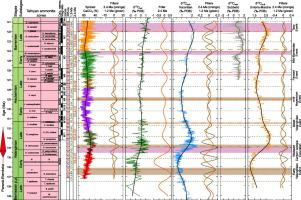Earth-Science Reviews ( IF 10.8 ) Pub Date : 2023-02-13 , DOI: 10.1016/j.earscirev.2023.104356 Mathieu Martinez , Beatriz Aguirre-Urreta , Guillaume Dera , Marina Lescano , Julieta Omarini , Maisa Tunik , Luis O'Dogherty , Roque Aguado , Miguel Company , Stéphane Bodin

|
Episodes of Environmental Change (EECs) were times of accelerated hydrological cycle that punctuated the Early Cretaceous. Uncertainties in the geologic time scales however preclude full understanding of the onset, unfolding, and termination of EECs. Here, we reanalyze the hemipelagic sedimentary series from France and Spain from the Valanginian to the Barremian to provide a comprehensive and accurate time scale of the Valanginian–Barremian interval based on the stable 405-kyr eccentricity cycle. According to our astrochonologic framework, the Weissert Event started 134.56 ± 0.19 Ma, in perfect synchronicity with the peak of volcanic activity of the Paraná-Etendeka Large Igneous Province. On average, EECs show a pacing of 2.40 Myr from the Valanginian to the Barremian, in phase with detrital supply and carbon isotope variations from marine carbonates. Long eccentricity cycles were hence key parameters in the regulation of climate and carbon cycles in the Early Cretaceous through changes in the detrital and nutrient supply, oceanic fertilization, organic carbon storage and global sea level. A long obliquity forcing, at 1.2 Myr, is also observed through the studied interval in both the detrital and carbon-isotope ratios series, allowing the identification of long isotopic stages in the Early Cretaceous. Our study highlights a positive correlation between continental runoff and sea-level change, suggesting that glacio-eustasy, and not aquifer-eustasy, was the main driver of global-sea level fluctuations during the Early Cretaceous. We also demonstrate that the humid peak related to the Weissert Event is driven by the pacing of the long orbital cycles despite the emplacement of the Paraná-Etendeka province. Nevertheless, in comparison to other EECs of the Valanginian–Barremian, the Weissert Event appears as a singularly long event with stronger impact on climate and marine ecosystems compared to other EECs. We posit that this is a consequence of the concomitant effect of the emplacement of the Paraná-Etendeka province and the long orbital cycles.
中文翻译:

早白垩世碳循环波动、火山活动和轨道强迫的同步
环境变化事件 (EECs) 是加速水文循环的时期,它打断了早白垩世。然而,地质时间尺度的不确定性妨碍了对 EEC 的开始、展开和终止的充分理解。在这里,我们重新分析了法国和西班牙从 Valanginian 到 Barremian 的半远洋沉积系列,以提供基于稳定的 405-kyr 偏心率周期的 Valanginian-Barremian 区间的全面而准确的时间尺度。根据我们的天文年代学框架,Weissert 事件开始于 134.56 ± 0.19 Ma,与 Paraná-Etendeka Large Igneous Province 的火山活动高峰期完全同步。平均而言,EEC 显示从 Valanginian 到 Barremian 的步调为 2.40 Myr,与海洋碳酸盐岩的碎屑供应和碳同位素变化同步。因此,通过碎屑和养分供应、海洋肥化、有机碳储存和全球海平面的变化,长离心率周期是早白垩世气候和碳循环调节的关键参数。在碎屑和碳同位素比值系列中的研究区间也观察到了 1.2 Myr 的长倾角强迫,从而可以识别早白垩世的长同位素阶段。我们的研究强调了大陆径流与海平面变化之间的正相关性,这表明冰川 - 海平面变化,而不是含水层 - 海平面变化,是早白垩世期间全球海平面波动的主要驱动因素。我们还证明,与 Weissert 事件相关的潮湿峰值是由长轨道周期的步调驱动的,尽管 Paraná-Etendeka 省就位了。尽管如此,与 Valanginian-Barremian 的其他 EEC 相比,Weissert 事件似乎是一个异常长的事件,与其他 EEC 相比,它对气候和海洋生态系统的影响更大。我们假设这是巴拉那-埃滕德卡省的安置和长轨道周期的伴随效应的结果。











































 京公网安备 11010802027423号
京公网安备 11010802027423号